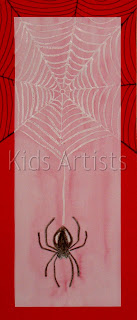- black paper A4 size
- black paper 23 by 32 cm
- oilpastel crayons
- scissors and glue
When colouring is finished, turn around the sheet. Draw a tree on the back, with five branches: one tho the right, one to the right edge of the paper, one to the middle above, one to the left edge of the sheet and one to the left. Branches have to be small at the end and wide near to the trunk. You've got six puzzlepieces now. Cut them out and place them on the larger black sheet. Use the cut tree to check if your pieces lie well. Pate all parts on the black sheet, exept the tree of course. Maybe you can do something fun with it?






























.jpg)















